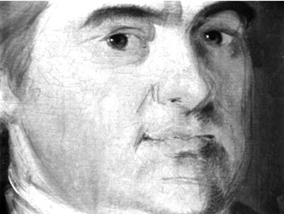 Christian Gullager Christian Gullager
Captain Offin Boardman, about 1787
Technical Notes
The support is a slightly open, plain-weave canvas with an average of eleven weft threads per centimeter and fifteen warp threads per centimeter; the canvas is unlined. Selvage edges are present on the top and bottom of the canvas; the width from one selvage edge to the other is 106.7 centimeters. Cusping is visible along all four edges.
The ground layer is warm white, has a pebbled texture, and does not extend over the tacking edges. It was applied moderately thick but does not hide the texture of the canvas.
In general, the paint was applied thinly. The portrait was painted somewhat more thickly in the whites and highlights of the flesh tones. There is also low impasto in some of the highlights. Most areas were first painted thinly and broadly, then developed using a wet-on-wet technique. Some highlights and fine details were added wet-on-dry. Many of the forms and brushstrokes have hard edges.
 |
 |
|
Figure 1. Infrared reflectogram showing the underdrawing in the face of Christian Gullager's portrait of Offin Boardman.
|
Evidence of a loose, crude underdrawing is visible in some areas of the face, waistcoat, and proper left hand. Examination with infrared vidicon confirms that Gullager began this composition with a quick graphite drawing of the face, coat, waistcoat, and proper left hand (fig. 1). Pentimenti and examination with infrared vidicon show that the artist changed the position of the collar of the coat, proper right hand, proper left cuff of the coat, spyglass, and upper buttons of the waistcoat. Infrared vidicon clearly shows that the proper right hand and spyglass were originally slightly higher than in the final portrait. Gullager also reduced the contours of the shoulders and arms. X-radiographs of the painting reveal that the artist used white lead paint throughout.
The edges that have been protected by the frame rabbet indicate that some fading has occurred in the pigments. The surface appears somewhat grimy and abraded. When the painting entered the museum's collection, it was reportedly unvarnished and dirty. There appear to be remnants of a previous surface coating under the present varnish, which is probably a synthetic resin (possibly PVA). The surface is slightly discolored and does not effectively saturate the paint surface.
Frame Notes
The frame, which is of single-piece construction, is a molded, Dutch-style, black wooden frame with a gilded sight edge. The corners have lap joint and half-miter construction. |